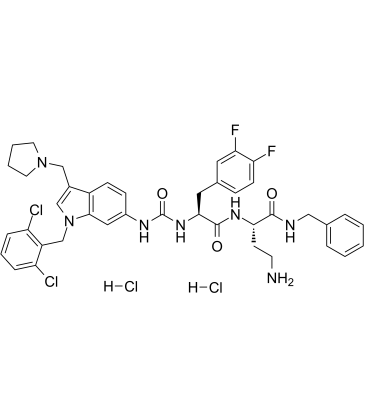2387505-58-8
| Name | RWJ-56110 dihydrochloride |
|---|
| Description | RWJ-56110 dihydrochloride is a potent, selective, peptide-mimetic inhibitor of PAR-1 activation and internalization (binding IC50=0.44 uM) and shows no effect on PAR-2, PAR-3, or PAR-4. RWJ-56110 dihydrochloride inhibits the aggregation of human platelets induced by both SFLLRN-NH2 (IC50=0.16 μM) and thrombin (IC50=0.34 μM), quite selective relative to U46619 (HY-108566). RWJ-56110 dihydrochloride blocks angiogenesis and blocks the formation of new vessels in vivo. RWJ-56110 dihydrochloride induces cell apoptosis[1][2]. |
|---|---|
| Related Catalog | |
| Target |
IC50: 0.44 uM (PAR-1) IC50: 0.16 μM (the aggregation of human platelets induced by SFLLRN-NH2) IC50: 0.34 μM (the aggregation of human platelets induced by thrombin)[1][2] |
| In Vitro | Proteinase-activated receptors (PARs) are a family of G protein-coupled receptors activated by the proteolytic cleavage of their N-terminal extracellular domain, exposing a new amino terminal sequence that functions as a tethered ligand to activate the receptors. RWJ56110 inhibits the aggregation of human platelets induced by both SFLLRN-NH2 (IC50=0.16 μM) and thrombin (IC50=0.34 μM) while being quite selective relative to collagen and the thromboxane mimetic U46619 (HY-108566)[1]. RWJ-56110 dihydrochloride is fully inhibits thrombin-induced RASMC proliferation with an IC50 value of 3.5 μM. RWJ-56110 dihydrochloride shows blockade of thrombin’s action with RASMC calcium mobilization (IC50=0.12 μM), as well as with HMVEC (IC50=0.13 μM) and HASMC calcium mobilization (IC50=0.17 μM)[1]. RWJ56110 (0.1-10 μM; 24-96 hours) inhibits endothelial cell growth dose-dependently, with half-maximal inhibitory concentration of RWJ56110 is approximately 10 μM[2]. RWJ56110 (0.1-10 μM; 6 hours) inhibits DNA synthesis of endothelial cells in a thymidine incorporation assays. Endothelial cells are in fast-growing state (50-60% confluence), RWJ56110 inhibits cell DNA synthesis in a dose-dependent manner, but when cells that are in the quiescent state (100% confluent), the inhibitory effect of PAR-1 antagonists is much less pronounced[2]. RWJ56110 (0.1-10 μM; pretreatment for 15 min) inhibits thrombin-induced Erk1/2 activation in a concentration-dependent manner. However, when endothelial cells are stimulated by FBS (final concentration 4%), it reduces partially the activated levels of Erk1/2[2]. RWJ56110 (30 μM; 24 hours) has an inhibitory effect on endothelial cell cycle progression. It reduces the percentage of cells in the S phase, while alterations in the percentages of G1 and G2/M cells are less pronounced[2]. Western Blot Analysis[2] Cell Line: Endothelial cells Concentration: 0 μM; 3 μM; 1 μM; 3 μM; 10 μM Incubation Time: Pretreatment for 15 min Result: Resulted in MAPK activation in Endothelial cells. Cell Cycle Analysis[2] Cell Line: Endothelial cells Concentration: 0 μM; 3 μM; 1 μM; 3 μM; 10 μM Incubation Time: Pretreatment for 15 min Result: Reduced cell number in S phase. |
| References |
| Molecular Formula | C41H45Cl4F2N7O3 |
|---|---|
| Molecular Weight | 863.65 |
